JAPANESE SWORDSWOMEN:
FUJI JUNKO, THE PREMIERE LADY YAKUZA
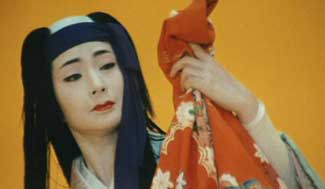 Glorious action-actress Junko Fuji may well have been the most charismatic swordswoman ever on the screen.
Glorious action-actress Junko Fuji may well have been the most charismatic swordswoman ever on the screen.
In The Red Peony Gambler series she is an oyabun or gambling boss who lives by the gamblers' code & inevitably ends up fighting for justice against corruption in her chosen or inherited world.
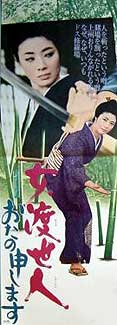 In this seven-film series she is shown to be powerful with tanto (knife), katana (sword), a markswoman with pistol, & a judo expert. In this seven-film series she is shown to be powerful with tanto (knife), katana (sword), a markswoman with pistol, & a judo expert.
This became her most famous of many similar roles & it set a standard for the 1960s "woman gambler" craze that produced similar films & series' for several superb actresses, though Junko's Red Peony remained the gold standard.
Many of the films outside the Red Peony series in which she stars or co-stars also allow her at least a bit of fighting, & often a great deal. Only her earliest films are liable to cast her as a weak character.
In The Orphan Gambler 1 (Onna toseinin, 1971) she is not an oyabun/boss as in the Red Peony series but a struggling neophyte acquiring enemies on her rise in the ritualized yakuza world. In the climax she is forced to take up sword against the villain, & there is no reluctance in her aggressive, lethal style.
In the first film her co-star is the sad-visaged Koji Tsuruta. In the immediate sequel Orphan Gambler 2 (Onna toseinin: Ota-no-moushimasu, 1971) her leading man is the lank almost spooky but very appealing Bunta Sugawara.
For her performance as The Orphan Gambler, plus for her seventh & final film about the Red Peony, Fuji Junko received the Kinema Junpo Award for year's best actress. They were to be her last films for some while, as she retired to raise a family, & when she returned to the screen she'd commemorate the renewed career with a new screen name, Sumikuo Fuji.
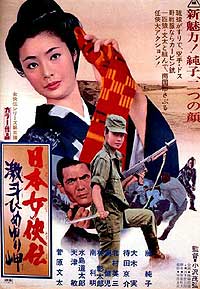 Trials of an Okinawa Village (Nihon jokyo-den: Gekito Himeyuri-misaki, 1971) is the fifth & final film of the Nihon jokyo-den series (enumerated in the appendix at the bottom of this page), although the films are related mainly in their chivalrous attitude & are not about the same array of characters but only of character-types. Trials of an Okinawa Village (Nihon jokyo-den: Gekito Himeyuri-misaki, 1971) is the fifth & final film of the Nihon jokyo-den series (enumerated in the appendix at the bottom of this page), although the films are related mainly in their chivalrous attitude & are not about the same array of characters but only of character-types.
The heroic character types around which these films are structured are chivalrous commoners (kyokaku) & further restricted to women of the chivalrous commoner category.
To some degree this series is the "female" counterpart to the Ken Takakura Nihon Kyokuden series which sometimes co-starred Ken Takakura, reversing Nihon Jokyo-den's focus on characters played by Junko & sometimes co-starring Ken. The two series could easily be mixed up together as a single bigger series.
In Trials Junko is a boss not over gamblers but this time of a trucking company. Yet a token scene allows her eager public to view her "taking" an American GI in a poker game (she cheats). But the theme is different from her standard role; she is not basically a gambler. She has run-ins with evil yakuza (& is aided by the standard "good" yakuza played by rawboned Bunta Sugawara) during the American occupation of Okinawa, an unusual time & setting for the ninkyo or chivalrous brand of yakuza film.
Her hometown is threatened by usurers, gangsters, & indirectly by American GI influences. She must go with her employees to help settle things, ultimately with violence.
As the setting is relatively modern, there is some gunplay; & though Junko gets to do damage with a rifle & a hand grenade (souvenir of the recent war), it is only when she gets longsword in hand that her capacity for beautiful vicious revenge reaches full fever.
She uses Okinawan karate several times in the film, but the ending is a protracted sword battle during which she gets in some good, grim, realistic fighting, killing the main villain most spectacularly.
In the typical yakuza film's portrayal of love affairs, the woman's comrade-in-arms (the "good" yakuza who invariably has sad expressive eyes) tends to get killed, & Trials of an Okinawa Village is no exception. Bunta's character from the mainland takes the blame for several score of murders. The Americans, disbelieving a mere woman could have used a sword that effectively, discount her claim to have taken equal part. The male lead is executed before an Occupation firing squad.
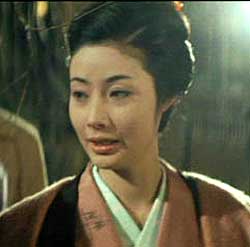 Various male leads starring opposite Junko Fuji, as well as actors co-starring with other female yakuza stars, have met equally pitiful ends in these ultimately predictable but gracefully entertaining "action tragedies." But one film famously spares the hero: Various male leads starring opposite Junko Fuji, as well as actors co-starring with other female yakuza stars, have met equally pitiful ends in these ultimately predictable but gracefully entertaining "action tragedies." But one film famously spares the hero:
When Junko retired in 1972 to marry a kabuki actor as delicate as Junko was tough, she made a last film with her most famous co-star, Ken Takakura, which was her farewell to the genre. She was only twenty-six years old, but wanted to raise a family. It would also be veteran director Masahiro Makino's last fim.
Historically Japanese firemen were heroic figures with tattooed backs & shoulders who risked their lives to keep fires from spreading & saving peoples' lives, powerful men who could rip wooden buildings apart in a hurry to create firebreaks.
Such men were lionized in block prints & hero-tales. And long before body tattoos were associated with gangsters & convicts, they were emblems of tough firemen.
Cherry Blossom Fire Gang (Junko intai kinen eiga: Kanto hizakura ikka, 1972) has also been shown under variant titles Red Cherry Gang of Kanto, Kanto Scarlet Cherry Gang, & The Red Cherry Blossom Family.
This was the big farewell film for Junko Fuji as she sides with Kanto firefighters against troublesome yakuza.
This film was the last of the "Kantoko" series aka "Kyokotsu Ichidai" or "Chivalrous Life" films. They've been issued in a boxed set, inclusive of Kyokaku Retsuden (1968), Gorotsuki (1968), Nihon Yakuza-den: Socho e no michi (1971), & the here-reviewed Junko intai kinen eiga: Kanto Hizakura Ikka (1972), plus a sixth bonus disc of material from Masahiro Makino's symposium at the 1991 Yufuin Film Festival.
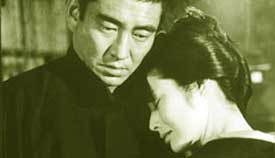 The fifth & last of these films provided to several actors who'd often co-starred with her in earlier films, notably Koji Tsuruta, Tomisaburo Wakayama, & Bunta Sugawara. The fifth & last of these films provided to several actors who'd often co-starred with her in earlier films, notably Koji Tsuruta, Tomisaburo Wakayama, & Bunta Sugawara.
"Nihon Ken" or "The Japanese Ken" -- as Takakura was widely known because he embodied everything good about Japanese masculinity -- was the leading man most treasured as Junko's recurring comrade-sweetheart.
It is almost whimsical how, after the main part of the Taisho period story of Cherry Blossom Fire Gang was over, Ken's character was not dead or shipped away to prison &, in fact, he & bold heroine get married & leave the gambling world forever.
Junko Fuji looks straight out of the film into the theater audience to thank us for supporting her career & bids us a tearful farewell. A number of years later (beginning in 1989) she would come out of retirement mainly to work in television under her new stage name Sumiko Junko. Her first return role would cast her opposite, who else, Ken Takakura.
Appendix:
The Nihon Jokyo-den "Tales
of Chivalrous Women" series:
1.
NIHON JOKYO-DEN: KYOKAKU GEISHA
(TALES OF CHIVALROUS WOMEN: SAMURAI GEISHA; aka THE CHILVALROUS GEISHA) 1969
Director: Kosaku Yamashita
2. NIHON JOKYO-DEN: MAKKA NO DOKYO BANA
(TALES OF CHIVALROUS WOMEN: BRAVE RED FLOWER OF THE NORTH) 1970
Director: Yasuo Furuhata
3. NIHON JOKYO-DEN: TEKKA GEISHA
(TALES OF CHIVALROUS WOMEN: THE IRON GEISHA
aka, A LIVELY GEISHA) 1970
Director: Kosaku Yamashita
4. NIHON JOKYO-DEN: KETTO MIDARE BANA
(TALES OF CHIVALROUS WOMEN: DUEL OF SWIRLING FLOWERS) 1971
Director: Kosaku Yamashita
5. NIHON JOKYO-DEN: GEKI TO HIME YURI MISAKI
(TALES OF CHIVALROUS WOMEN: TRIALS OF AN OKINAWA VILLAGE) 1971
Director: Shigehiro Ozawa
copyright © by Paghat the Ratgirl
|
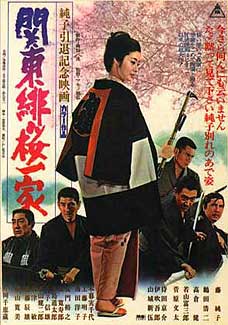

 In this seven-film series she is shown to be powerful with tanto (knife), katana (sword), a markswoman with pistol, & a judo expert.
In this seven-film series she is shown to be powerful with tanto (knife), katana (sword), a markswoman with pistol, & a judo expert.

 The fifth & last of these films provided to several actors who'd often co-starred with her in earlier films, notably Koji Tsuruta, Tomisaburo Wakayama, & Bunta Sugawara.
The fifth & last of these films provided to several actors who'd often co-starred with her in earlier films, notably Koji Tsuruta, Tomisaburo Wakayama, & Bunta Sugawara.